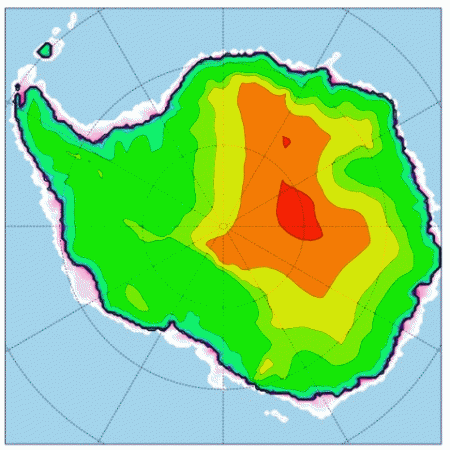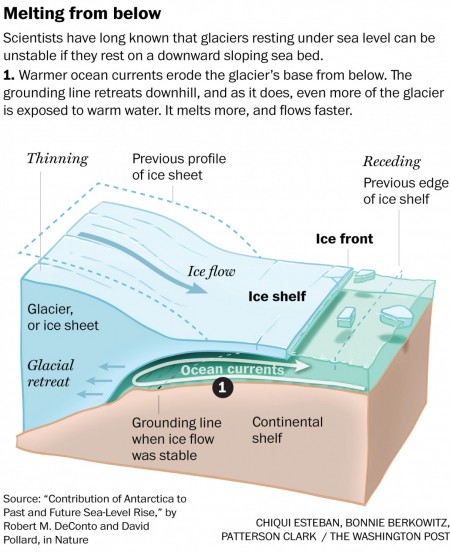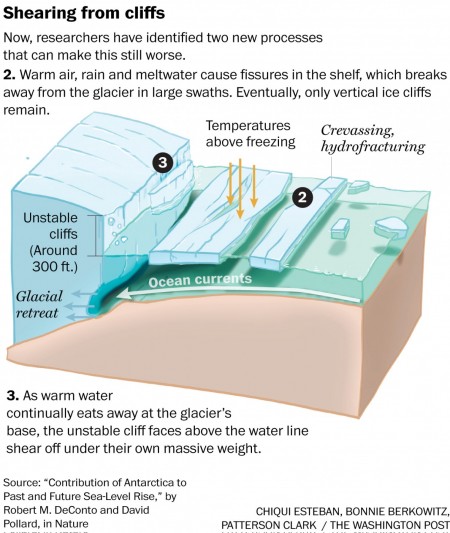April 3, 2016 – How sensitive is Antarctica to global warming? We have seen numerous studies and read National Oceanic and Atmospheric Administration reports showing while the Earth’s atmosphere warmed the extent of ice in the Southern Ocean actually increased. Climate change skeptics seized on this information to proclaim global warming a hoax. But a new study appearing in Nature, entitled, “Contribution of Antarctica to past and future sea-level rise,” produces compelling evidence for more than a meter sea level rise by 2100 and 15 meters (close to 50 feet) by 2500 “if emissions continue unabated.”
In reconstructing global mean sea levels from past warming periods dating back 3 million years, the researchers, Robert DeConto, Geosciences Professor at University of Massachusetts-Amherst, and David Pollard, Senior Scientists, Earth and Environmental Systems Institute, Pennsylvania State University, see a disturbing picture showing sea levels 10 to 30 meters higher than the present day. The evidence can be found in sediment deposits found on the Antarctic continent‘s margins. The more recent late Pleistocene interglacial warmings provide evidence from 130,000 and 115,000 years ago. At these times sea levels were 6 to 9 meters higher than today. CO2 levels 3 million years ago were approximately 400 parts per million (similar to today), but the late Plesitocene CO2 figure is 280 parts per million and global mean temperatures were between 0 and 2 Celsius warmer at the time.
How much of this rise is attributed to Antarctica versus Greenland?
Considering the ice mass at the South Pole, Antarctica’s contribution to global mean sea level rise is much more significant. But what is the mechanism that makes Antarctica a “wild card” when talking about global warming?
It is the precarious nature of the ice shelves on the continent’s margins and their relation to the on land ice fields abutting them. A warming ocean undermines the ice shelves making them thinner. Evidence of that is visible today. When the erosion of the shelves reaches a critical point they simply collapse. We have seen evidence of this in the past two decades with ice shelves like Larson B on the Antarctic peninsula suddenly breaking up in 2002.
In addition to the warming ocean, warming atmospheric temperatures impact the ice fields. On Greenland over the last two decades warming has led to glacial lakes forming on ice field surfaces. These lakes feed streams that eventually find fissures dropping their load to the bedrock and undermining land-based ice. This has led to a number of Greenland glaciers suddenly increasing the speed of their flow and increasing the calving of ice bergs into the surrounding North Atlantic. In Antarctica the surface melt doesn’t have the same access to the Southern Ocean but it does erode ice sheets below and the margins that abut the ice shelves can be further undermined. This ultimately destabilizes the shelves holding the continental ice back from advancing into the Southern Ocean.
The authors of the study recreated the conditions of 3 million years ago as well as those of the late Pleistocene (around 128,000 years back). They did high-resolution modeling of the palaeoclimates of these two periods and then ran the models. The 3 million years ago model raised ocean sea levels by 11.3 meters just from Antarctic contributions. The late Pleistocene model produced 6 to 7.5 meter increases.
They then ran simulations 5,000 years into the future based on current and projected rises in CO2 levels and the correlated rise in atmospheric temperatures. They assumed “no ocean warming beyond 2300” maintaining stable ocean temperatures as CO2 atmospheric concentrations stabilized and began to decline. The end result indicated that until the “global ocean cools….a multi-millennial commitment to several meters of sea-level rise despite human-engineered CO2 drawdown” would persist.
The authors indicate that their model needs further refinement to incorporate the feedback mechanisms from rapid calving and ice margin collapses that could trap ice in Antarctic bays negatively impacting ice melt rates. Also the model needs to incorporate continental deformation impact, that is, the isostatic rise of Antarctica’s land mass, as the burden of ice melts from the surface causing the land to rise. This too could impact ocean sea level rises. But even without these refinements the authors point out the accuracy of the simulations of the ancient sea level events going back 3 million years.
In the conclusion they state, “ocean-driven melt is an important driver of grounding-line retreat where warm water is in contact with ice shelves, but in scenarios with high greenhouse gas emissions we find that atmospheric warming soon overtakes the ocean as the dominant driver of Antarctic ice loss. Surface meltwater may lead to the ultimate demise of the major buttressing ice shelves…..but it is the long thermal memory of the ocean that will inhibit the recovery of marine-based ice for thousands of years after greenhouse gas emissions are curtailed.”
What are the implications for human civilization living within 100 kilometers of most of the world’s oceans? The projection to the year 2500 has enormous impact on global cities. Putting it in perspective using a few select locations in the United States, it means the disappearance of Delaware, much of eastern Maryland, almost all of Manhattan and Brooklyn, Miami and Fort Lauderdale, and a significant portion of the Central Valley of California.
Which brings us to the ultimate question. Is this our inevitable future?
At COP21 the nations of the world agreed to address CO2 levels and begin transitioning to a low-carbon future. Existing damage from current CO2 levels cannot be undone for a number of centuries, but allowing CO2 levels to further escalate means real consequences for generations that follow us.
As Jake Tapper, a CNN commentator, in breaking the results of the study on his network, stated, “Your kids and your grand kids…might not be able to dream about living in New York City or Philadelphia or Washington or Miami because there might not be a New York City or Philadelphia or Washington or Miami at the turn of the century.”











